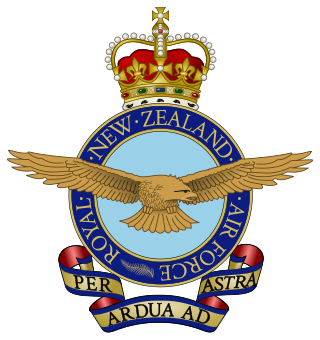
The Royal New Zealand Air Force (RNZAF) is the aerial service branch of the New Zealand Defence Force. It was formed from New Zealand elements of the British Royal Air Force, becoming an independent force in 1923, although many RNZAF aircrew continued to serve in the Royal Air Force until the end of the 1940s.

No. 3 Squadron RNZAF is a unit of the Royal New Zealand Air Force (RNZAF). It currently operates NHIndustries NH90 and Agusta A109 helicopters. The squadron was initially formed as a territorial unit of the New Zealand Permanent Air Force in Christchurch in 1930. During World War II, the squadron served in the Pacific, undertaking patrol operations. In the early post war period, the squadron was converted to a Territorial formation flying fixed wing aircraft, but later converted to rotary wing aircraft, and returning to permanent status. Since then, personnel from the squadron have served in the Vietnam War, East Timor, Singapore, the Sinai, and the Solomon Islands.

No. 2 Squadron RNZAF was a squadron of the Royal New Zealand Air Force (RNZAF). It was formed in 1930 as part of the Territorial Air Force with the main headquarters at Wellington and shadow flights at New Plymouth and Wanganui. Squadron personnel conducted their annual flying at RNZAF Base Wigram. In 1937 the Territorial Squadrons were re-organised and No. 2 Squadron became the Wellington Territorial Squadron.

14 Squadron RNZAF is a squadron of the Royal New Zealand Air Force. In 2015 the squadron was re-raised and equipped with 11 Beechcraft T-6 Texan II. A new aerobatic display team called the Black Falcons was also formed using the new aircraft. They replaced the RNZAF display team known as the Red Checkers.

RNZAF Base Woodbourne is a base of the Royal New Zealand Air Force, located 8 km west of Blenheim.

RNZAF Base Auckland is a Royal New Zealand Air Force base located near the upper reaches of the Waitematā Harbour in Auckland, New Zealand. The base formerly comprised two separate airfields, Whenuapai and RNZAF Station Hobsonville. Hobsonville was established as a seaplane station in 1928 and was the RNZAF's primary flying boat base in New Zealand until 1967. Construction of Whenuapai as a base for Vickers Wellington bomber aircraft began in 1937, the hangars being built in 1939. Whenuapai was also Auckland's civil international airport from 1945 to 1965. After World War II Auckland became a centre for RNZAF transport and maritime squadrons. RNZAF Station Hobsonville was administratively joined with Whenuapai in 1965 to become RNZAF Base Auckland. Hobsonville subsequently became a grass airfield for No. 3 Squadron RNZAF, which later moved to Ohakea. A New Zealand Army unit comprising various personnel from different regiments as well as the New Zealand Special Air Service were relocated to Papakura Military Camp in 2003.

No. 488 Squadron was the name given to two distinct Royal New Zealand Air Force squadrons during the Second World War. Both were formed under Article XV of the Empire Air Training Scheme and served under the operational command of the Royal Air Force.

No. 6 Squadron RNZAF is a maritime squadron of the Royal New Zealand Air Force. It has a history going back to World War II, when it operated flying boats, and has been disbanded and re-formed several times through changes in the country's military structure. The squadron motto, originally "Fortitudine et Diligentia", is now “Vigilance with Patience”.

Air Commodore Keith Logan "Grid" Caldwell CBE, MC, DFC & Bar was a New Zealand fighter ace of the Royal Flying Corps in World War I who also rose to the rank of Air Commodore in the Royal New Zealand Air Force during World War II.
No. 4 Squadron RNZAF was a Royal New Zealand Air Force (RNZAF) patrol bomber unit that served in the South Pacific during World War II.
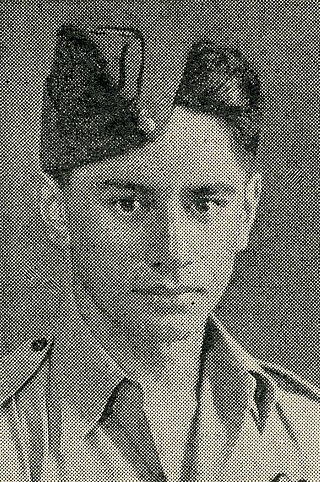
Bert Sam Wipiti, DFM was a New Zealand fighter pilot and flying ace of the Second World War. Born in New Plymouth, he enlisted in the Royal New Zealand Air Force (RNZAF) in 1941 and when he was posted to No. 243 Squadron in Singapore, he was the first Māori airman to leave New Zealand for active duty. Following the Japanese invasion of British Malaya, he destroyed five Japanese aircraft before being evacuated to Java in February 1942. He later flew with the RNZAF's No. 485 Squadron in Europe and was killed on operations while escorting bombers on a raid over France.
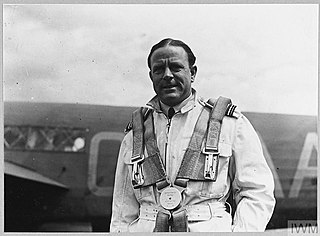
Cyril Eyton Kay, known as Cyrus Kay, was a New Zealand aviator and military leader. Born in Auckland, Kay joined the Royal Air Force in 1926 for a five-year period of service, during which time he attempted to break the record for the fastest flight from England to Australia. He remained in aviation in civilian life and was a participant in the MacRobertson Air Race of 1934.

The Royal New Zealand Air Force (RNZAF) is organised into a small number of flying squadrons and ground-based units. Most of the RNZAF's operational and training units are stationed at RNZAF Base Auckland and RNZAF Base Ohakea in the North Island. Several training and maintenance units are located at RNZAF Base Woodbourne in the South Island.

No. 41 Squadron was a transport unit of the Royal New Zealand Air Force (RNZAF). The squadron was formed in 1944, and conducted transport flights in the south Pacific during World War II. It remained active after the war, and flew supplies to the New Zealand occupation force in Japan. Three crews from the squadron participated in the Berlin Airlift during 1948 and 1949, and one of its flights was temporarily based in Singapore from 1949 to 1951. From 1955 the entire squadron was stationed at Singapore, from where it participated in the Malayan Emergency, Indonesia–Malaysia confrontation and Vietnam War. Detachments of No. 41 Squadron were also based in Thailand from 1962 to 1965. The squadron was disbanded in 1977.

The history of aviation in New Zealand began in the late 19th century when balloon flights began. In the first decade of the 20th century, several New Zealanders began developing heavier-than-air craft with the first confirmed powered flight in New Zealand being made by Vivian Walsh in 1911. The First World War spurred the development of aviation in New Zealand. A flying school was established and several hundred New Zealanders went on to serve in British flying services in Europe.

Michael James Herrick, was a New Zealand flying ace of the Royal Air Force (RAF) during the Second World War. He is credited with having shot down at least six enemy aircraft.

Air Vice-Marshal Ian Gordon Morrison was a New Zealand aviator and military leader. Born in Hanmer Springs, he briefly served in the Royal Air Force before transferring to the Royal New Zealand Air Force in 1939. During the early stages of the Second World War, he was a bomber pilot with No. 75 Squadron, which was formed mostly with New Zealand personnel and operated Vickers Wellingtons. He returned to New Zealand in 1940 for instructing duties and then was a staff officer with the RNZAF's No. 1 Islands Group, based in Vanuatu. He later commanded No. 3 Squadron during the Solomons campaign. After the war, he held a series of staff posts before becoming Chief of Air Staff of the RNZAF in 1962. In this capacity he replaced much of the air force's dated equipment and sought to improve its strike capacity. Appointed a Companion of the Order of the Bath in 1965, he retired the following year. He died in 1997, aged 83.

John Arthur Houlton was a New Zealand flying ace of the Royal New Zealand Air Force (RNZAF) during the Second World War. He was credited with the destruction of at least five German aircraft.
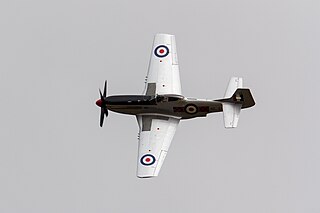
Developed as a fighter interceptor, the North American P-51 Mustang was widely used during the Second World War, both in a fighter and fighter-bomber role. New Zealand ordered 130 Mustangs in early 1945 but the first 30 of these were placed in storage when they arrived in the country later in the year due to the end of the war. The remainder of the order was cancelled. In 1951, the stored Mustangs were assembled for use by the New Zealand Territorial Air Force and equipped four of its fighter squadrons until withdrawn from service in 1955. A few were also operated by the Royal New Zealand Air Force until 1957. The surviving Mustangs were sold off, most of them for scrap.
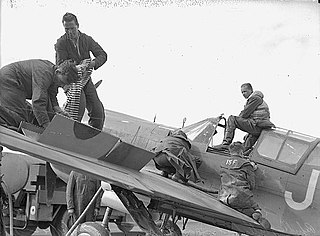
Percival "Guy" Newton, was a flying ace of the Royal New Zealand Air Force (RNZAF) during the Second World War. He was credited with the destruction of at least five enemy aircraft.


























